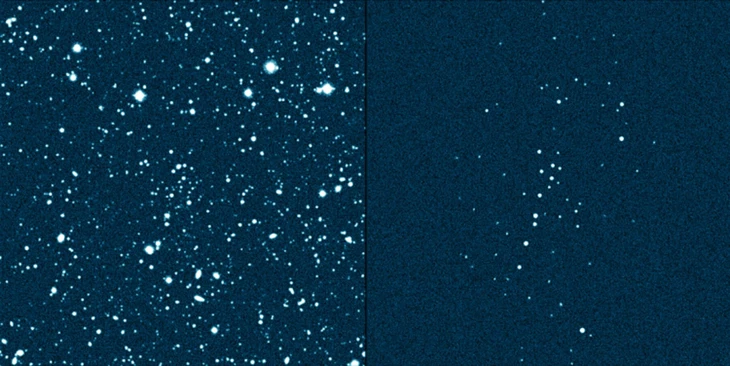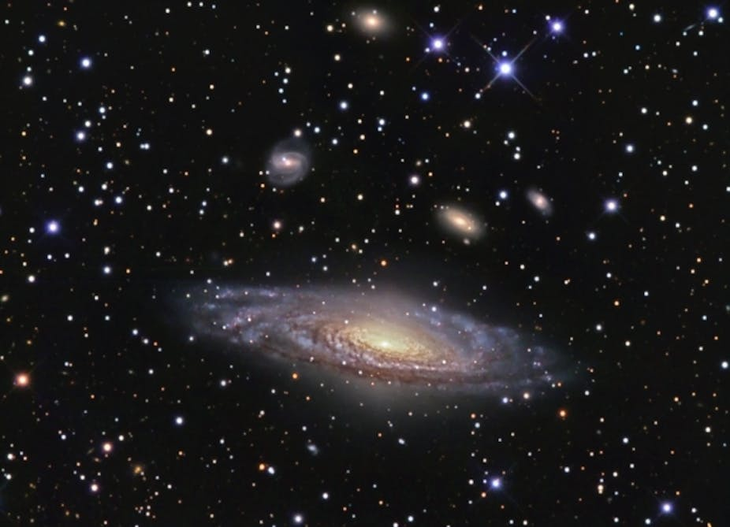
Uma3/U1 (right) is a small star system in the constellation Ursa Major that astronomers recently discovered - Photo: CFHT / S. Gwyn / S. Smith
By basic definition, a galaxy is a giant star system containing millions to billions of stars and dominated by dark matter, while a star cluster is just a small group of a few hundred to a few thousand stars, without dark matter.
However, a special type of dwarf galaxy blurs the line between the two concepts. These galaxies can contain thousands of times more dark matter than luminous matter, making them very difficult to observe.
The latest example is UMa3/U1, a small star system in the constellation Ursa Major that astronomers recently discovered.
UMa3/U1 is just 20 light-years in diameter and contains about 60 stars with a total luminous mass equivalent to 16 Suns.
If it is a galaxy, it would be the smallest and most dark matter-rich galaxy ever discovered. If it is a star cluster, it could be the oldest, up to 11 billion years old.
Even its name is disputed. If it is a galaxy, the correct name would be Ursa Major III (a satellite of the Big Dipper). If it is a star cluster, the correct name is UNIONS 1, as it was discovered by the UNIONS (Ultraviolet Near Infrared Optical Northern Survey) survey.

Studying and exploring the universe, including planets, stars, galaxies, black holes, and other cosmic phenomena, to understand the origin, structure, movement and evolution of the universe is a difficult problem of astronomy - Photo: NASA
According to Universe Today, a research team from the Royal Astronomical Society has applied two main methods to classify the true nature of UMa3/U1.
The first method focuses on the dynamical simulation element. The team assumed UMa3/U1 was a star cluster and simulated the process of "evaporation". This is the phenomenon of stars gradually escaping the cluster because the gravitational force is not strong enough to hold them.
The results suggest that the system could remain stable for another 2 to 3 billion years. Such a long lifespan suggests that the structure could be a long-term stable star cluster, rather than a galaxy.
The second method is based on Mass Function Analysis. This method evaluates how mass is distributed in a stellar system.
In star clusters, mass is generally distributed evenly, while in galaxies, especially dwarf galaxies, stars tend to be densely concentrated in the center. However, because old core stars such as white dwarfs and neutron stars have very low luminosity, they are almost impossible to observe with current instruments. This makes the collected data insufficient for definitive confirmation.
Based on the above two analyses, astronomers initially concluded that UMa3/U1 could be a very old cluster, with a lifespan of about 11 billion years. However, they also emphasized that more observations, especially from other extremely faint galaxies, are needed to draw a final conclusion.
In the near future, the appearance of the Vera C. Rubin Observatory is expected to open up many new discoveries about ultra-faint dwarf galaxies (UFD), thereby helping scientists better understand the history of formation and evolution of the universe.
Source: https://tuoitre.vn/phat-hien-thien-ha-nho-nhat-vu-tru-20250512135559892.htm



![[Photo] President Luong Cuong receives US Secretary of War Pete Hegseth](https://vphoto.vietnam.vn/thumb/1200x675/vietnam/resource/IMAGE/2025/11/02/1762089839868_ndo_br_1-jpg.webp)


![[Photo] Lam Dong: Images of damage after a suspected lake burst in Tuy Phong](https://vphoto.vietnam.vn/thumb/1200x675/vietnam/resource/IMAGE/2025/11/02/1762078736805_8e7f5424f473782d2162-5118-jpg.webp)






























































































Comment (0)